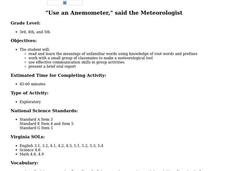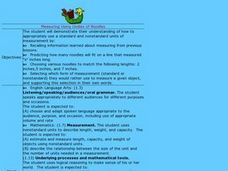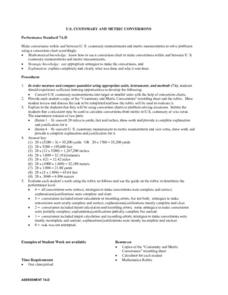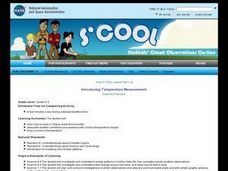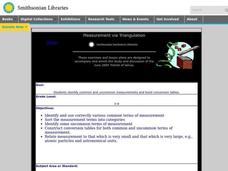Curated OER
Technology Lesson Plan
Students measure various objects using non-standard units. The goal is for them to practice measuring in order to apply the physical act to various objects found in the classroom. The lesson is ideal for the kinesthetic learners and...
Curated OER
What Is Your Measure
Students engage in the study of measurement. They practice using different objects that can be found in class or brought from home. Students are introduced to the history of measurement. They compare and contrast the standard and metric...
Curated OER
"Use an Anemometer," said the Meteorologist
Students work in groups to make an instrument the Meteorologists use to measure the speed of the wind after the teacher reads them a poem about the wind. Students then review vocabulary that they studied from their lesson.
Curated OER
Supermarket Shopping
Learners participate in studying that a kilogram is a standard unit of measurement. They measure practical objects using length, mass, and capacity. They measure a number of supermarket items using units and scales.
Curated OER
Measuring Using Oodles of Noodles
First graders explore and evaluate the use of both standard and nonstandard forms of measurement. They use noodles to measure the lengths of each line they have drawn. They glue the noodles to the page under the given line.
Curated OER
Measuring the Classroom
Students measure their classroom and determine the area. They discuss the margin of error. Each class member will write up their results separately. Students must decide what measurements to make, and attempt to measure accurately.
Curated OER
Measurement Benchmarks and Conversions
Students explore the concept of measurement. In this measurement instructional activity, students determine appropriate units of measure for objects in the classroom. Students discuss the importance of measuring objects with the same...
Curated OER
Do Objects Vary Very Much?
Students examine the concept of standard deviation, calculating mean, and collecting data. They measure the standard deviation in a bag of M&M candy, record the data, and calculate the mean.
Curated OER
Putting Your Best Foot Forward
Third graders measure their feet and their parents' feet, record data on computer-generated graphs, and calculate and record mean, median, and mode.
Curated OER
Ice Cream Lesson Plan for Kindergarten
Students explore how ice cream is made in a factory and at home. They help make ice cream in the classroom. They measure out the ingredients. Students share the ice cream when it is done.
Curated OER
Foot Book Lesson Plan
Students measure items using non-standard units of measure. In this measurement lesson, students listen to Dr. Seuss', The Foot Book, before using oak tag feet to measure items. They use a large foot and a smaller one to measure...
Curated OER
U.S. Customary and Metric Conversions
Students convert U.S. customary measurements into larger or smaller units with the help of conversion charts. They are explained that they are going to use conversion charts in problem solving situations. Pupils use a calculator to...
Curated OER
Mapping a Temperature Field
Students measure and graph temperatures. In this temperature field lesson students use a map to measure and plot field values and construct isolines and interpret the results.
Curated OER
Plugged in to CO2
Students use a meter to measure the energy used and carbon produced by electronics and appliances. In this environmental science and technology lesson, students use a Kill-A-Watt meter to determine the electricity used by everyday...
Curated OER
Commutative Property
First graders use various models to learn the Commutative Property of Addition. In this Commutative Property lesson, 1st graders use other students, counters, balances, and dominoes to apply the addition property. Students solve addition...
Curated OER
Metric Measurements
Sixth graders convert metric units of measurement. Classmates observe the use of a mnemonic for conversions. In groups, 6th graders practice converting metric units. They use a chart to describe how to convert between metric units of...
Curated OER
Slosh, Dribble, and Plop
Students recognize the need for a standard unit of volume. They estimate and measure to the nearest liter. Also they relate the liter to the familiar everyday containers.
Curated OER
Introducing Temperature Measurement
Students explore temperature and use Celcius thermometers to measure and graph the temperature in the classroom daily. They estimate what they think the temperature might be and then find the actual temperature in the room.
Curated OER
Creeping
Students observe, measure, and graph a model of slow down slope movement representing soil creep. This task assesses students' abilities to collect, record, and organize data, set up graph axes, plot data points, draw line graphs, apply...
Curated OER
Measurements in Science
Eighth graders demonstrate knowledge of metric tools by measuring common objects in the classroom. They discuss the various units of metric measurement and the scientific tools used to take them. They copy a metric ladder from a Web site.
Curated OER
Measurement Via Triangulation
Students investigate various common terms of measurement, sort them into categories, select the uncommon terms, and construct conversion tables for both the common and the uncommon terms of measurement.
Curated OER
Ruler and Magnifying Fun
First graders investigate objects using rulers and magnifying glasses. They record their observations using a data-recording sheet and write a characteristic for each item they observe. They use the ruler to solve math problems.
Pennsylvania Department of Education
Adding Common Fractions
Fourth graders estimate various measurements. In this lesson on measurement, 4th graders estimate the length and mass of multiple objects. Students discuss the difference between a guess and a reasonable estimate and discuss using...
Curated OER
He Came Out Of Nowhere!
Students calculate the traveled speed and distance of a robot. In this geometry lesson, students use the distance formula to manipulate and use to solve for the required variable. They calculate answers where two variables are...


